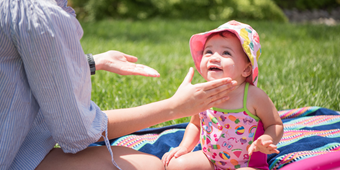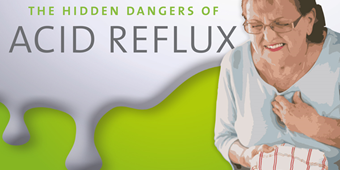What’s the Truth About Food And Acne?

Answer a few questions and we'll provide you with a list of primary care providers that best fit your needs.
There’s lots of misinformation out there about foods that aggravate acne. Despite what you and your teen might think, studies show that chocolate, fried foods, and candy do not cause pimples.
Certain foods and diets, though, may increase or lower the risk of acne. And increased hormone levels that accompany puberty can lead to the red bumps and whiteheads of acne.a
What Causes Acne?
When your child begins adolescence, changes in hormone levels signal the fat glands in the skin to make more sebum. Sebum protects the skin and keeps it supple.
When oily sebum mixes with dead skin cells and other debris on the skin, such as dirt, the pores or hair follicles can clog and become infected or inflamed.
You may notice changes in your child’s skin – especially around the nose and middle of the face – as early as age 9. Signs include skin bumps and coarsened pores.
How Diet Impacts Acne
What you and your teen eat can help promote healthy skin. And
Researchers are studying specifically how acne reacts to diets rich in high-glycemic or low-glycemic foods, milk, and protein.
High-glycemic foods result in quick spikes in blood sugar, while low-glycemic foods have a smaller, slower impact on blood sugar.
Low-glycemic diet. The American Academy of Dermatology says studies in Australia, Korea, Turkey, and the U.S. have found that a low-glycemic diet may reduce the amount of acne, reducing spikes in blood sugar and inflammation in the body. Low-glycemic foods include:
- Beans
- Fresh fruits
- Fresh vegetables
- Steel cut oats
High-glycemic diet. When your blood sugar spikes after eating carbohydrates, your body produces more sebum, which can lead to acne. Foods with a high glycemic index include:
- Corn flakes
- Doughnuts
- Pastries
- Potato chips
- Puffed rice
- Sugary drinks such as milkshakes and soda
- White bread
- White potatoes or fries
- White rice
The evidence remains mixed. While some findings show that following a low-glycemic diet can lead to fewer acne breakouts, other studies have not found a connection between a high-glycemic diet and acne.
There does seem to be a correlation between a high-glycemic diet and worsening acne. The American Academy of Dermatology says that more research is needed.
Proteins and leucine. Certain meats, like beef and chicken, contain an amino acid called leucine. Leucine turns on the chain reaction that stimulates the skin's oil glands and makes acne breakouts more likely.
Milk. The American Academy of Dermatology says that some studies show a possible link between drinking milk and an increase in acne. Research conducted in Italy, Malaysia, and the U.S. found that those who drink more milk (skim, low-fat, or whole) are more likely to have acne.
Scientists are not sure why milk worsens acne. Hormones in milk may cause inflammation inside the body, clogging pores and leading to acne. No studies show that milk-based products like yogurt or cheese lead to more breakouts.
You and your child also can monitor breakouts to pinpoint a cause. When a breakout occurs, ask these questions:
- Does any food or beverage seem to trigger a breakout or worsen existing acne?
- If something seems to trigger a breakout, what happens when you don’t have that food or beverage for a day, a week, or a month?
Know Your Acne Triggers
While changes in hormone levels are the primary cause of acne, the skin condition can be caused by other triggers, such as:
- Iodine. Some people develop acne after consuming foods with high iodine content. Acne has been linked to the high iodine levels in kelp, a seaweed extract sometimes used in sports drinks.
- Medicine. Some medicines, including steroids, epilepsy medications, and lithium can impact the skin.
- Menstruation. Some girls also get more pimples before and during their periods. This is caused by changes in hormone levels.
- Stress. Adolescence is a stressful time. If your child experiences acne outbreaks related to stress, taking steps to control stress can help.
Treatments: Medicines And Proper Skin Care
 Different treatments for acne are available, depending on your specific condition:
Different treatments for acne are available, depending on your specific condition:
- Over-the counter lotions. If your child is living with mild to moderate acne, over-the-counter lotions with benzoyl peroxide can help.
- Medicines. When acne becomes more severe or persistent, your pediatrician or a dermatologist can prescribe medicines to help.
- Hormone treatments. Sometimes a hormone imbalance causes severe or persistent acne in girls who have excess male hormones. This can be treated.
- Proper skin care. Encourage your teen to avoid oil-based skin and hair products and use non-perfumed, water-based products.
Some acne treatments are made from vitamin A. If your child is using one of these medicines, he or she should avoid taking a vitamin A supplement.
Vitamin A is fat-soluble and stored in the body. It can build up to toxic levels. If you take too much vitamin A, you may experience:
- Headaches
- Liver damage
- Nerve damage
- Skin and hair problems
Research suggests that it’s unlikely a change in diet will clear up a case of acne. Medicine and proper skin care can help. Talk with your doctor about the best treatment for you.
Answer a few questions and we'll provide you with a list of primary care providers that best fit your needs.
Source: American Academy of Dermatology; Healthy Children; Verywell Health




